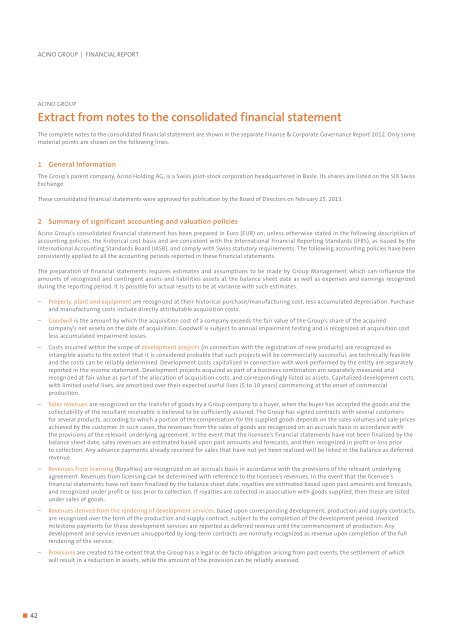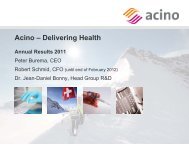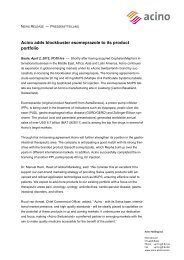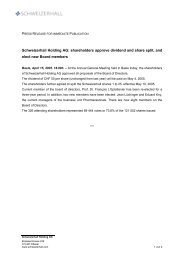Annual Report 2012 - Acino
Annual Report 2012 - Acino
Annual Report 2012 - Acino
You also want an ePaper? Increase the reach of your titles
YUMPU automatically turns print PDFs into web optimized ePapers that Google loves.
42<br />
ACINO GROUP | FINANCIAL REPORT<br />
ACINO GROUP<br />
Extract from notes to the consolidated financial statement<br />
The complete notes to the consolidated financial statement are shown in the separate Finance & Corporate Governance <strong>Report</strong> <strong>2012</strong>. Only some<br />
material points are shown on the following lines.<br />
1 General Information<br />
The Group’s parent company, <strong>Acino</strong> Holding AG, is a swiss joint-stock corporation headquartered in Basle. Its shares are listed on the sIX swiss<br />
Exchange.<br />
These consolidated financial statements were approved for publication by the Board of Directors on February 25, 2013.<br />
2 Summary of significant accounting and valuation policies<br />
<strong>Acino</strong> Group’s consolidated financial statement has been prepared in Euro (EUR) on, unless otherwise stated in the following description of<br />
accounting policies, the historical cost basis and are consistent with the Inter national Financial <strong>Report</strong>ing standards (IFRs), as issued by the<br />
International Accounting standards Board (IAsB), and comply with swiss statutory requirements. The following accounting policies have been<br />
consistently applied to all the accounting periods reported in these financial statements.<br />
The preparation of financial statements requires estimates and assumptions to be made by Group management which can influence the<br />
amounts of recognized and contingent assets and liabilities assets at the balance sheet date as well as expenses and earnings recognized<br />
during the reporting period. It is possible for actual results to be at variance with such estimates.<br />
– Property, plant and equipment are recognized at their historical purchase/manufacturing cost, less accumulated depreciation. Purchase<br />
and manufacturing costs include directly attributable acquisition costs.<br />
– Goodwill is the amount by which the acquisition cost of a company exceeds the fair value of the Group’s share of the acquired<br />
company’s net assets on the date of acquisition. Goodwill is subject to annual impairment testing and is recognized at acquisition cost<br />
less accumulated impairment losses.<br />
– Costs incurred within the scope of development projects (in connection with the registration of new products) are recognized as<br />
intangible assets to the extent that it is considered probable that such projects will be commercially successful, are technically feasible<br />
and the costs can be reliably determined. Development costs capitalized in connection with work performed by the entity are separately<br />
reported in the income statement. Development projects acquired as part of a business combination are separately measured and<br />
recognized at fair value as part of the allocation of acquisition costs, and correspondingly listed as assets. Capitalized development costs,<br />
with limited useful lives, are amortized over their expected useful lives (5 to 10 years) commencing at the onset of commercial<br />
production.<br />
– sales revenues are recognized on the transfer of goods by a Group company to a buyer, when the buyer has accepted the goods and the<br />
collectability of the resultant receivable is believed to be sufficiently assured. The Group has signed contracts with several customers<br />
for several products, according to which a portion of the compensation for the supplied goods depends on the sales volumes and sale prices<br />
achieved by the customer. In such cases, the revenues from the sales of goods are recognized on an accruals basis in accordance with<br />
the provisions of the relevant underlying agreement. In the event that the licensee’s financial statements have not been finalized by the<br />
balance sheet date, sales revenues are estimated based upon past amounts and forecasts, and then recognized in profit or loss prior<br />
to collection. Any advance payments already received for sales that have not yet been realized will be listed in the balance as deferred<br />
revenue.<br />
– Revenues from licensing (Royalties) are recognized on an accruals basis in accordance with the provisions of the relevant underlying<br />
agreement. Revenues from licensing can be determined with reference to the licensee’s revenues. In the event that the licensee’s<br />
financial statements have not been finalized by the balance sheet date, royalties are estimated based upon past amounts and forecasts,<br />
and recognized under profit or loss prior to collection. If royalties are collected in association with goods supplied, then these are listed<br />
under sales of goods.<br />
– Revenues derived from the rendering of development services, based upon corresponding development, production and supply contracts,<br />
are recognized over the term of the production and supply contract, subject to the completion of the development period. Invoiced<br />
milestone payments for these development services are reported as deferred revenue until the commencement of production. Any<br />
development and service revenues unsupported by long-term contracts are normally recognized as revenue upon completion of the full<br />
rendering of the service.<br />
– Provisions are created to the extent that the Group has a legal or de facto obligation arising from past events, the settlement of which<br />
will result in a reduction in assets, while the amount of the provision can be reliably assessed.








